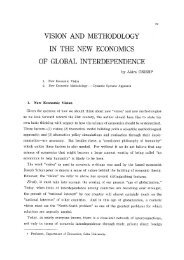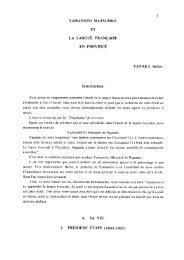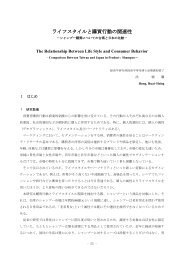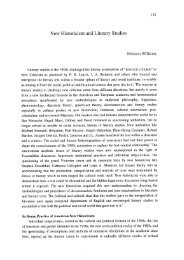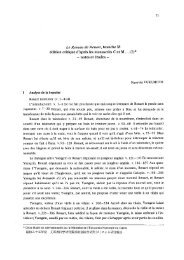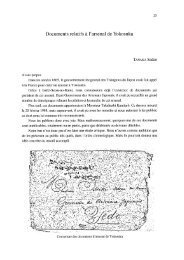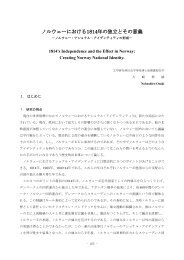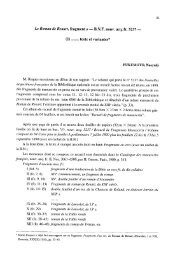Indian Writing in English 1794-2004 - Soka University Repository
Indian Writing in English 1794-2004 - Soka University Repository
Indian Writing in English 1794-2004 - Soka University Repository
You also want an ePaper? Increase the reach of your titles
YUMPU automatically turns print PDFs into web optimized ePapers that Google loves.
190<br />
stage. Literary critics and historians have occasionally branched out <strong>in</strong> their own preferred ideo-<br />
logical directions, be it Marxist, postcolonial or conservative, but they have not been able to<br />
devise a clear method to study the subject. Most of us have not been able to develop a clear<br />
methodology to study the subject, nor have we acquired the critical tools to justify our choices.<br />
Now as India matures and <strong>Indian</strong> writ<strong>in</strong>g <strong>in</strong> <strong>English</strong> f<strong>in</strong>ds a laudable place <strong>in</strong> the literary mar-<br />
kets of the world, we need to harness the tools of the new methodologies <strong>in</strong> literary theory, soci-<br />
ology, political science, economics and history to study the uniqueness of <strong>Indian</strong> culture and<br />
experience as represented <strong>in</strong> its literature composed <strong>in</strong> <strong>English</strong>. We need to ask new questions<br />
about the colonial and post-colonial subject and unravel the <strong>in</strong>tricate work<strong>in</strong>g of the Empire, the<br />
relationship between knowledge and power, and the local hegemonies of caste and religion that<br />
also helped to create <strong>Indian</strong> literature <strong>in</strong> <strong>English</strong>. F<strong>in</strong>ally we should be able to use the energy of<br />
the new discipl<strong>in</strong>e that we must create to redraw the boundaries of <strong>Indian</strong> literature <strong>in</strong> <strong>English</strong><br />
and provide valuable guides to future generations.<br />
NOTES<br />
i In India various literary anthologies prescribed for the <strong>English</strong> departments at various univer-<br />
sities imag<strong>in</strong>ed an upper class H<strong>in</strong>du literature for the nation ignor<strong>in</strong>g Muslim, Anglo-<strong>Indian</strong>,<br />
<strong>Indian</strong> Christian or Parsee writers. S<strong>in</strong>ce the last decade the works of Michael Foucault,<br />
Benedict Anderson and Edward Said have been widely used by scholars to understand the<br />
way national literatures are imag<strong>in</strong>ed by an educated elite and the ideology of construct<strong>in</strong>g<br />
local and national identities along national l<strong>in</strong>es. The construction of national literatures and<br />
through them national identities has been an ongo<strong>in</strong>g project <strong>in</strong> many nations s<strong>in</strong>ce the beg<strong>in</strong>-<br />
n<strong>in</strong>g of the twentieth century if not earlier. In Great Brita<strong>in</strong> F. R. Leavis was clandest<strong>in</strong>ely<br />
concentrat<strong>in</strong>g on the Arnold project to create a national literature while he was campaign<strong>in</strong>g<br />
for the autonomy of the literary text <strong>in</strong> his critical writ<strong>in</strong>g. In the United States the production<br />
and dissem<strong>in</strong>ation of the Norton anthologies of literature privileged most white male writers<br />
elid<strong>in</strong>g Black travel narratives, Native American folk and other m<strong>in</strong>ority literatures <strong>in</strong>clud<strong>in</strong>g<br />
Japanese American. As a selective literature was read by a large section of the public it forged<br />
a selective national identity where the dom<strong>in</strong>ant majority—be it white or upper caste H<strong>in</strong>du—<br />
def<strong>in</strong>ed issues rang<strong>in</strong>g from culture and politics to economics and education. This bias to<br />
some extent is be<strong>in</strong>g corrected by the publication of critical works on and about national liter-<br />
atures by literary historians like Stephen Greenblatt (United States), South Asianists like<br />
Chris Bayly (U.K.) and literary scholars like Vijay Dhardwadker, Gaytri Spivak Chakravorty<br />
(United States). New critical approaches have <strong>in</strong>troduced critical literary readers like The<br />
Heath Anthology <strong>in</strong> two volumes which has now replaced the Norton anthologies <strong>in</strong> the<br />
United States Now there are various literary anthologies that highlight the contributions of<br />
erstwhile elided m<strong>in</strong>orities <strong>in</strong> the construction of national literatures.<br />
ii E. F. Oaten, A Sketch of Anglo-<strong>Indian</strong> Literature, {London: Kegan Paul, 1908). Also see<br />
Bhupal S<strong>in</strong>gh, A Survey of Anglo-<strong>Indian</strong> Fiction, (Rowman and Littlefield, 1975) and Concise<br />
Cambridge History of <strong>English</strong> Literature, (ELBS, 1972).<br />
iii The Anglo-<strong>Indian</strong> or Eurasian communities not only identified with the rul<strong>in</strong>g British but also<br />
abhorred the vast <strong>Indian</strong> populace. The <strong>English</strong> felt that the special privileges to the Anglo-<br />
<strong>Indian</strong>s were worth it as they strengthened British rule <strong>in</strong> India. The British Viceroy Lord



